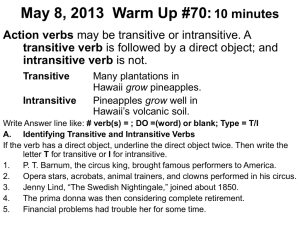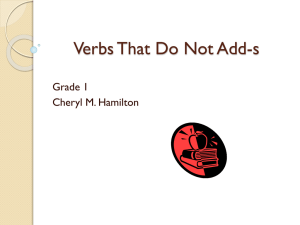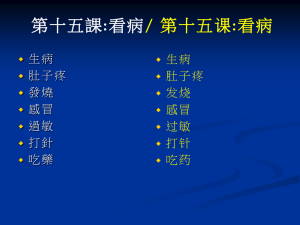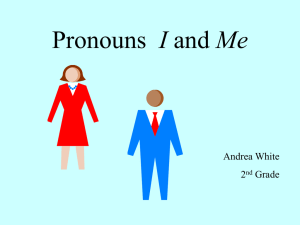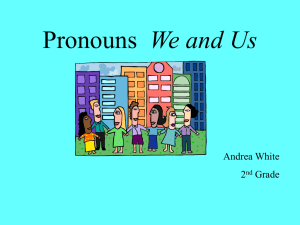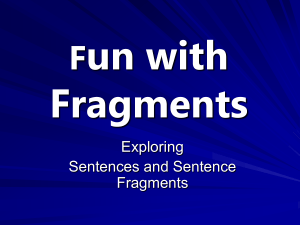Transitive & Intransitive Verbs, Direct & Indirect Objects
advertisement
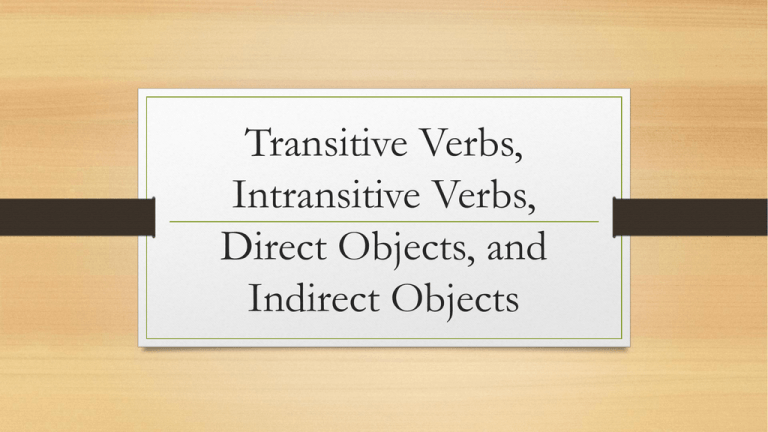
Transitive Verbs, Intransitive Verbs, Direct Objects, and Indirect Objects Action Verbs • Express physical or mental activity Run, Ponder, Think, Throw, Contemplate Transitive Verb • A transitive verb is an action verb that has a direct object—a word that tells who or what receives the action of the verb • She trusts her friend. • Zora Neale Hurston wrote the book. • Elsa froze the city. Intransitive Verb • An intransitive verb is an action verb that does not have an object that tells who or what receives the action of the verb. • The audience applauded. • The train stops here. The Same Verb May be Transitive or Intransitive Depending on its Function • • • • Amelia swam the channel. Amelia swam for hours. Belinda weeds the garden. Belinda weeds every day. Are the following verbs transitive or intransitive? • • • • • • • I studied my geometry notes for an hour. Luis also studied for an hour. We are planting some dahlias. They should bloom in about six weeks. The strong winds died down. We quickly packed a lunch for our trip to the seashore. The sunlight sparkled on the splashing surf. The Direct Object of a Verb • The direct object is a noun, pronoun, or word group that tells who or what receives the action of a transitive verb or shows the result of that action. Remember that a transitive verb is always an action verb. • To find the direct object, ask “What?” or “Whom?” of the transitive verb. • I took my little sister to see a movie. (Took whom? sister) • She had already seen it four times. (Seen what? it) A Direct Object May Precede the Subject and Verb • What remarkable tricks the illusionist performed. (Performed what? Tricks). A Direct Object is Never Found in a Prepositional Phrase • Tom was driving in his car. [Car is part of the prepositional phrase in his car. The sentence has no direct object] • Tom was driving his car. [Driving what? Car is the direct object] Identify the Direct Objects in the Following Sentences • • • • • • I borrowed my parents’ new camera. First, I loaded the film into the camera. Then, I set the shutter speed. I focused the camera on a distant object. I could read the shutter speed in the viewfinder. A flashing red light signals an incorrect setting. Indirect Object • An Indirect Object is a noun, pronoun, or word group that often appears in sentences containing direct objects. An indirect object tells to whom or to what (or for whom or for what) the action of a transitive verb is done. • Molly read us her report. [Molly read the report to whom? Us] • They feed the horses some oats. [They fed the oats to what? Horses] • Joan left you a message. [Joan left the message for whom? You] • Carly knitted her pet Doberman a sweater. [Carly knitted a sweater for what? Doberman] If the word to or for is used, the noun or pronoun following it is part of a prepositional phrase and cannot be an indirect object. • Jeff wrote a note to me. [Me is part of the prepositional phrase to me and cannot be an indirect object] • Jeff wrote me a note. [Wrote a note to whom? Me is the indirect object]. Identifying Direct and Indirect Objects • • • • • • Last summer, Leroy told us his plans for the future. He wants a place on the U.S. Olympic swim team. Of course, his goal demands hours of practice. Such intense training could cost him his social life. However, we all understand and give him much encouragement and support. Maybe we’ll see Leroy at the next Olympics!


